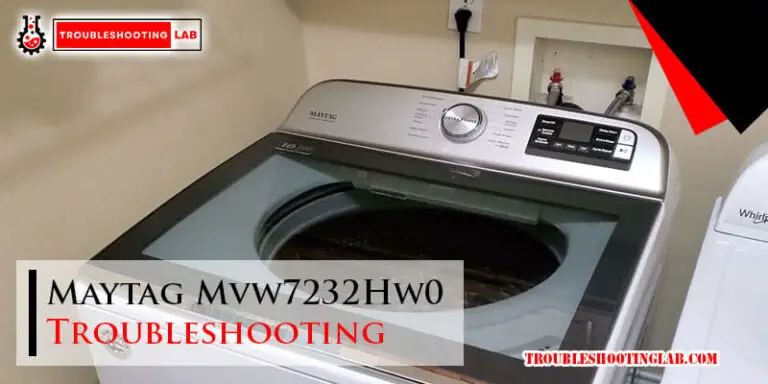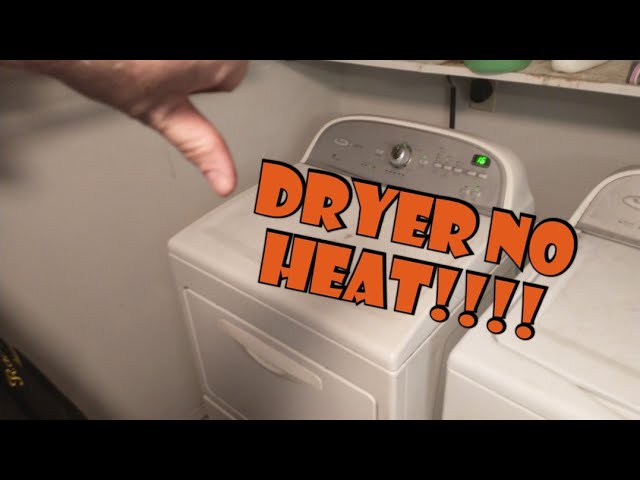Whirlpool Gas Dryer Troubleshooting: Expert Tips & Solutions
Are you facing issues with your Whirlpool gas dryer and feeling frustrated? You’re not alone.
Many people encounter problems with their dryers, and it can be a real headache. But don’t worry, we’re here to help you solve those pesky issues and get your dryer back in tip-top shape. Imagine the satisfaction of your clothes coming out perfectly dry every time, without the hassle of unexpected breakdowns.
We’ll walk you through simple troubleshooting steps that you can do yourself. You’ll discover how to identify common problems and learn quick fixes that save you time and money. Whether your dryer isn’t heating, won’t start, or is making strange noises, we’ve got you covered. Get ready to transform your laundry experience by mastering the art of dryer troubleshooting. Keep reading to regain control of your appliance and bring peace back to your laundry days.

Credit: www.youtube.com
Common Dryer Issues
Dealing with a Whirlpool gas dryer that isn’t performing as expected can be frustrating. When your dryer stops working efficiently, it’s time to roll up your sleeves and dive into some troubleshooting. Understanding common dryer issues is the first step to restoring your appliance to its former glory. Whether it’s a lack of heat or an unexpected symphony of noises, identifying the problem helps you find a solution faster.
No Heat Production
Have you ever tossed a load of damp clothes into the dryer, only to find them just as wet after the cycle? This issue might be due to no heat production. First, check if the dryer is receiving gas and the gas valve is open. Sometimes, the thermal fuse might be blown, preventing heat generation. Replacing a faulty fuse can often solve the problem.
Drum Not Spinning
Picture this: you load your dryer, press start, and hear the motor humming, but the drum stubbornly stays put. This might be a belt issue. The drive belt could be broken or slipped off. Inspect it for wear and tear, and replace it if necessary. Also, ensure the drum rollers are not worn out and spinning freely.
Excessive Noise
Is your dryer producing a symphony of rattles and thuds? Excessive noise can be a sign of worn out bearings or drum support rollers. Tighten loose screws or bolts. Check if foreign objects are stuck in the drum. Sometimes, debris can cause a racket. Regular cleaning can prevent these nuisances.
Dryer Not Starting
You press start, but your dryer remains silent. First, check the power supply. Ensure the plug is securely in the socket. Inspect the door switch; if it’s faulty, the dryer won’t start. Examine the control board for any signs of damage or burn marks. Replacing damaged components can breathe life back into your dryer.
Each issue your dryer faces is a puzzle waiting to be solved. As you troubleshoot, ask yourself: is the problem something you can handle, or is it time to call in a professional? Understanding your dryer’s quirks can save you time and stress. What’s your Whirlpool dryer story? Share your experience in the comments below.
Pre-troubleshooting Steps
Before tackling any issues with your Whirlpool gas dryer, it’s crucial to follow pre-troubleshooting steps. These steps ensure safety and can often identify simple problems. Understanding these basics may save time and prevent further damage.
Safety Precautions
Ensure the dryer is unplugged before inspection. Avoid touching any internal parts when the dryer is connected. Check for gas leaks by smelling for gas or listening for hissing sounds. Ventilate the area to prevent any gas accumulation. Wear gloves to protect your hands from sharp edges.
User Manual Consultation
Refer to the user manual for specific guidance on your model. The manual often has troubleshooting tips and diagrams. Familiarize yourself with the layout and function of key components. Review any error codes that might appear on the display. Knowing these codes can pinpoint specific problems.
Basic Checks
Inspect the power cord for damage. Ensure it is properly connected. Check the gas supply valve to make sure it is open. Verify that the lint filter is clean. A clogged filter can affect dryer efficiency. Examine the dryer drum for any obstructions. Remove any items that may cause blockages.
Diagnosing Heat Problems
Heat problems in your Whirlpool gas dryer can be frustrating. They can cause clothes to remain damp or take longer to dry. Identifying the source of the issue can save time and repair costs. Three main components can affect the heating: the thermal fuse, gas supply, and igniter.
Thermal Fuse Inspection
A blown thermal fuse can stop the dryer from heating. It acts as a safety device, preventing overheating. You can find it on the blower housing or the dryer’s heat source. Use a multimeter to check if it conducts electricity. If not, replace the fuse to restore function.
Gas Supply Check
The gas supply must be steady for the dryer to heat. Ensure the gas valve is open. Check for any kinks in the gas line. A blocked or restricted line can reduce gas flow. Inspect connections for leaks using soapy water. Bubbles indicate a leak, needing immediate repair.
Igniter Functionality
The igniter lights the gas burner for heat production. A faulty igniter will prevent heating. Visually inspect it for cracks or breaks. Test with a multimeter to ensure it has continuity. No reading suggests it needs replacing. An operational igniter glows brightly during use.

Credit: www.whirlpool.com
Resolving Drum Issues
Is your Whirlpool gas dryer’s drum not spinning properly? It’s easy to feel overwhelmed when laundry piles up, but resolving drum issues can be simpler than you think. By understanding a few key components, you can tackle these problems head-on and keep your dryer running smoothly.
Belt Condition Assessment
The belt is a critical component that keeps the drum turning. Over time, it can wear out or snap, leading to a non-spinning drum. To assess the belt’s condition, unplug your dryer and remove the front panel.
Once you have access, gently tug on the belt. A belt in good condition should be taut. If it feels loose or shows signs of wear like cracks or fraying, it’s time to replace it. You might have replaced a belt before, but if not, don’t worry—it’s a relatively straightforward fix that can save you from bigger issues down the road.
Motor And Pulley Check
The motor and pulley system are the heart of your dryer’s drum movement. If the drum isn’t spinning, the motor may be at fault. First, ensure the dryer is unplugged, then inspect the motor for any signs of burning or unusual noises.
Check the pulley for any obstructions or signs of wear. A personal tip: I once found a small sock caught in the pulley, which was stopping the drum from turning. Removing such obstructions can often solve the issue instantly.
Roller And Bearing Examination
Drum rollers and bearings provide support and enable smooth rotation. Worn-out rollers can cause the drum to wobble or make strange noises. To examine them, remove the drum from the dryer carefully.
Look for flat spots or wear on the rollers. If they don’t spin freely or appear damaged, replace them. Bearings should also move smoothly without grinding. Have you ever noticed a rhythmic thumping noise? It might be a sign that a roller or bearing needs attention.
By focusing on these key areas, you can often resolve drum issues without professional help. What’s your experience with troubleshooting your appliances? Feel free to share your tips or questions in the comments below. Let’s keep the conversation going and help each other maintain our appliances efficiently.
Addressing Noise Concerns
Experiencing strange sounds from your Whirlpool gas dryer? Addressing noise concerns quickly can prevent further issues. Identify common culprits like loose components or foreign objects to maintain efficient dryer performance.
If your Whirlpool gas dryer is making unexpected noises, it can be more than just an annoyance. Strange sounds might indicate a problem that could worsen if not addressed. Understanding what these noises mean and how to fix them can save you time and money. Let’s dive into some practical steps to help you identify and resolve these noise concerns.Loose Parts Identification
Loose parts in your dryer can lead to rattling or thumping sounds. Begin by unplugging your dryer and checking the drum, belt, and fasteners. Tighten any loose screws and ensure the drum is properly aligned. If you hear a banging noise, the drum may be off balance. Adjust it carefully and test the dryer to see if the noise persists. A simple adjustment can often make a big difference.Blower Wheel Inspection
A worn or clogged blower wheel can create a humming or grinding noise. To inspect it, safely remove the dryer’s back panel. Look for lint or debris that might be caught in the wheel. If the wheel is damaged or worn out, replacing it might be necessary. You can find replacement parts at most appliance stores or online. Always ensure you have the correct model number when purchasing parts.Lint Filter And Vent Cleaning
Clogged lint filters and vents not only cause noise but also pose a fire hazard. Make it a habit to clean the lint filter after each drying cycle. Check the vent hose for blockages and clean it every few months. A clean vent system ensures your dryer runs smoothly and efficiently. It also reduces the risk of overheating, which can lead to strange noises. Have you noticed any changes after cleaning the vent? Addressing these common noise concerns not only extends the life of your dryer but also enhances its performance. By taking proactive measures, you can keep your appliance running quietly and efficiently. Have you tackled any of these issues before? Share your experiences and insights in the comments below.Fixing Startup Failures
Experiencing startup failures with your Whirlpool gas dryer can be frustrating. Identifying the root cause is essential to resolving the issue. It often involves checking several components. Addressing these can save you time and money. Let’s dive into the steps to troubleshoot startup failures.
Power Source Verification
First, verify the power source. Ensure the dryer is plugged in securely. Check the outlet by plugging in another device. Confirm that the circuit breaker has not tripped. If the outlet works, the issue lies elsewhere. This step eliminates basic power issues.
Start Switch Testing
The start switch could be faulty. Locate the start switch behind the control panel. Use a multimeter to test for continuity. If there is no continuity, replace the switch. This ensures the dryer receives the start signal.
Door Switch Examination
The door switch is crucial for operation. Make sure the door is closing properly. Open the dryer door and press the door switch. It should click when pressed. Use a multimeter to check continuity if needed. A faulty door switch prevents the dryer from starting.
Maintenance Tips
Ensuring your Whirlpool gas dryer runs efficiently involves regular maintenance. Proper upkeep can extend the lifespan of your appliance. It also helps in preventing unexpected breakdowns. Dive into these maintenance tips to keep your dryer in top shape.
Regular Cleaning Routine
Clean the lint filter after each use. This prevents build-up, which can cause fires. Use a vacuum to remove lint from the exhaust vent monthly. Check the drum for any leftover debris. Wipe it down with a damp cloth. Ensure the dryer’s exterior remains dust-free. This enhances airflow and efficiency.
Component Replacement Schedule
Inspect the dryer belt every year for wear. Replace it if you see cracks or frays. Change the gas valve coils every few years. They control the gas flow to the burner. Check the drum rollers and bearings. If they’re noisy, replace them to avoid further damage.
Professional Service Considerations
Schedule a professional service check annually. Experts can spot issues early. They ensure all components work correctly. A professional can also clean areas you can’t reach. This includes the dryer’s interior ductwork. Regular checks prevent costly repairs later.

Credit: www.whirlpool.com
When To Call A Professional
Encounter persistent issues like strange noises or ineffective drying? Contact a professional for reliable Whirlpool gas dryer troubleshooting. Ensure safety and optimal performance by consulting an expert when simple fixes don’t work.
When dealing with a Whirlpool gas dryer, DIY fixes seem tempting. But some problems require professional intervention. Knowing when to call a professional ensures safety and efficiency. Below are scenarios warranting expert help.Complex Repairs
Gas dryers have intricate systems and components. Attempting complex repairs without expertise can worsen the problem. Specialized tools and knowledge ensure a proper fix. Professionals have access to diagnostic equipment. They identify issues quickly and efficiently.Warranty Considerations
Tampering with the dryer might void the warranty. Check your warranty terms before attempting repairs. Authorized technicians maintain warranty integrity. They perform repairs adhering to manufacturer guidelines. This ensures peace of mind and product longevity.Safety Concerns
Gas dryers pose safety hazards. Incorrect repairs can lead to gas leaks. This increases the risk of fire or explosions. Professionals ensure all safety protocols are followed. They have the training to handle gas connections safely. Prioritizing safety protects your home and family.Frequently Asked Questions
Why Is My Whirlpool Gas Dryer Not Heating?
A clogged vent or faulty igniter can cause no heat. Check them first.
How Do I Reset My Whirlpool Dryer?
Unplug the dryer for five minutes. Plug it back in to reset.
What Does It Mean If My Dryer Won’t Start?
Check the power supply. Also, inspect the door switch and thermal fuse.
Why Is My Dryer Making Loud Noises?
Noises often mean loose parts or worn-out drum rollers. Inspect these components.
How Often Should I Clean My Dryer’s Lint Filter?
Clean the lint filter after every load. It prevents overheating and fires.
Conclusion
Troubleshooting a Whirlpool gas dryer can be straightforward. Check the basics first: power supply and settings. Listen for unusual sounds. Look for error codes on the display. Clear any lint from vents regularly. This helps improve efficiency and safety. Use the manual for specific instructions.
If issues persist, consider contacting a professional. Regular maintenance prevents many problems. It saves time and extends the dryer’s life. Understanding these steps helps you maintain your dryer with ease. Keep your appliance running smoothly and enjoy hassle-free laundry days.






